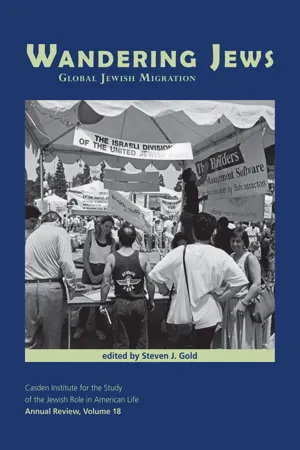
- 280 pages
- English
- ePUB (mobile friendly)
- Available on iOS & Android
About this book
Despite the importance of historical and contemporary migration to the American Jewish community, popular awareness of the diversity and complexity of the American Jewish migration legacy is limited and largely focused upon Yiddish-speaking Jews who left the Pale of Settlement in Eastern Europe between 1880 and 1920 to settle in eastern and midwestern cities.
Wandering Jews provides readers with a broader understanding of the Jewish experience of migration in the United States and elsewhere. It describes the record of a wide variety of Jewish migrant groups, including those encountering different locations of settlement, historical periods, and facets of the migration experience. While migrants who left the Pale of Settlement in the late nineteenth and early twentieth centuries are discussed, the volume's authors also explore less well-studied topics. These include the fate of contemporary Jewish academics who seek to build communities in midwestern college towns; the adaptation experience of recent Jewish migrants from Latin America, Israel, and the former Soviet Union; the adjustment of Iranian Jews; the experience of contemporary Jewish migrants in France and Belgium; the return of Israelis living abroad; and a number of other topics. Interdisciplinary, the volume draws upon history, sociology, geography, and other fields.
Written in a lively and accessible style, Wandering Jews will appeal to a wide range of readers, including students and scholars in Jewish studies, international migration, history, ethnic studies, and religious studies, as well as general-interest readers.
Frequently asked questions
- Essential is ideal for learners and professionals who enjoy exploring a wide range of subjects. Access the Essential Library with 800,000+ trusted titles and best-sellers across business, personal growth, and the humanities. Includes unlimited reading time and Standard Read Aloud voice.
- Complete: Perfect for advanced learners and researchers needing full, unrestricted access. Unlock 1.4M+ books across hundreds of subjects, including academic and specialized titles. The Complete Plan also includes advanced features like Premium Read Aloud and Research Assistant.
Please note we cannot support devices running on iOS 13 and Android 7 or earlier. Learn more about using the app.
Information
Jewish Identity among Contemporary Jewish Immigrants in the United States
INTRODUCTION
IMMIGRATION TO THE UNITED STATES
Jewish Immigrants
Contemporary Jewish Immigration
Table of contents
- Cover
- Title Page
- Copyright
- Contents
- Foreword
- Editorial Introduction: Recent Advancements in Jewish Migration Studies
- Jewish Identity among Contemporary Jewish Immigrants in the United States
- The Process of Immigration to the United States and the Acculturation of Iranian Jews
- Repatriating by Non-State Actors? The Emergence of (Skilled) Return Migration Industry in Israel
- Jews Residing in Three Cities in France and Belgium: Patterns of Ethnic Identity and Identification
- “Cleaniness Like That of the Germans”: Eastern European Jews’ Views of Germans and the Dynamics of Migration and Disillusionment
- Other Maps: Reflections on European Jewish Refugees’ Migration to the United States in the Early Postwar Era
- “It’s the Community That We’ve Made”: Jewish Migration to East Lansing, Michigan, in the Postwar Era
- About the Contributors
- About the USC Casden Institute